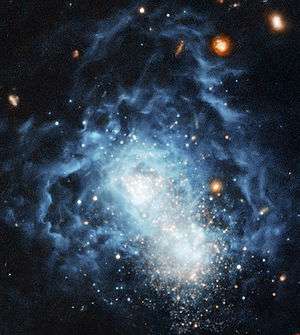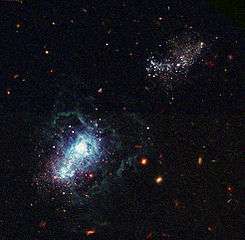I Zwicky 18
I Zwicky 18 is a dwarf irregular galaxy located about 59 million light years away[2] in the constellation Ursa Major. The galaxy was first identified by Swiss astronomer Fritz Zwicky in a 1930s photographic survey of galaxies.[3]
| I Zw 18 | |
|---|---|
 | |
| Observation data (J2000 epoch) | |
| Constellation | Ursa Major |
| Right ascension | 09h 34m 02.0s[1] |
| Declination | +55° 14′ 28″[1] |
| Redshift | 751 ± 2 km/s[1] |
| Distance | 0.059 Gly |
| Apparent magnitude (V) | 16.0[1] |
| Characteristics | |
| Type | I,[1] Starburst Galaxy |
| Apparent size (V) | 0′.3 × 0′.2[1] |
| Other designations | |
| UGCA 166,[1] Mrk 116[1] PGC 027182[1] | |
Age
Studies at the Palomar Observatory some 40 years ago led astronomers to believe that the galaxy erupted with star formation billions of years after its galactic neighbors. Galaxies resembling I Zwicky 18's youthful appearance are typically found only in the early universe. Early observations with the Hubble Space Telescope suggested an age of 500 million years old for I Zwicky 18.[4] The Hubble Space Telescope, however, later found faint, older stars contained within the galaxy, suggesting its star formation started at least one billion years ago and possibly as much as ten billion years ago. The galaxy, therefore, may have formed at the same time as most other galaxies.[5]
Contents

Spectroscopic observations with ground-based telescopes have shown that I Zwicky 18 is almost exclusively composed of hydrogen and helium, the main ingredients created in the Big Bang. The galaxy's primordial makeup suggests that its rate of star formation has been much lower than that of other galaxies of similar age. The galaxy has been studied with most of NASA's telescopes, including the Spitzer Space Telescope, the Chandra X-ray Observatory, and the Far Ultraviolet Spectroscopic Explorer (FUSE). However, it remains a mystery why I Zwicky 18 formed so few stars in the past, and why it is forming so many new stars right now.[2]
In 2015 a study found a very large region of ionised helium in this small galaxy, which tends to be more frequent in very distant galaxies with low presence of metals. The ionization of helium implies the presence of objects emitting a radiation intense enough to knock electrons off the helium atoms.[6] Scientists therefore conclude that I Zwicky 18 must contain Population III stars, which are almost absent in all other galaxies in the local universe.[7]
Distance
Astronomers at the Space Telescope Science Institute in Baltimore, Maryland and the European Space Agency discerned the distance by observing Cepheid variable stars within I Zwicky 18. These massive flashing stars pulse in a regular rhythm. The timing of their pulsations is directly related to their brightness. The team determined the observed brightness of three Cepheids and compared it with the actual brightness predicted by theoretical models. These models were calculated specifically for I Zwicky 18's deficiency in heavy elements, indicating the galaxy's stars formed before these elements were abundant in the universe. The Cepheid distance also was validated through the observed brightness of the brightest red stars older than one billion years.[5]
The Hubble data suggest that I Zwicky 18 is 59 million light-years from Earth. The galaxy's larger-than-expected distance may explain why astronomers have had difficulty detecting older, fainter stars within the galaxy. The faint, old stars in I Zwicky 18 are almost at the limit of Hubble's resolution and sensitivity.[8]
Classification
I Zwicky 18 is classified as a dwarf irregular galaxy and also a blue compact galaxy[9] and a starburst galaxy.[10] I Zwicky 18 is much smaller than our Milky Way and a mere 3,000 light-years across.[11] I Zwicky 18 may still be creating Population III stars—spectroscopy shows that its stars are composed almost entirely of hydrogen and helium, with heavier elements almost completely absent.[12] The concentrated bluish-white knots embedded in the heart of the galaxy are two major starburst regions where stars are forming at a furious rate. The wispy blue filaments surrounding the central starburst regions are bubbles of gas that have been blown away by stellar winds and supernovae explosions from a previous generation of hot, young stars. This gas is now heated by intense ultraviolet radiation unleashed by a new generation of hot, young stars.[13]
References
- "NASA/IPAC Extragalactic Database". Results for I Zw 18. Retrieved 2007-03-15.
- "Hubble Finds 'Dorian Gray' Galaxy". HubbleSite NewsCenter. Retrieved 2007-10-16.
- Ken Croswell (2001). The Universe at Midnight: Observations Illuminating the Cosmos. Free Press. p. 111. ISBN 0684859319.
- "Hubble Uncovers a Baby Galaxy in a Grown-Up Universe". NASA. December 1, 2004.
- "Hubble shows 'baby' galaxy is not so young after all" (Press release). Hubblesite: NASA. October 16, 2007. Retrieved 2015-03-24.
- "IZw18: the galaxy that reveals the history of the universe". Instituto de Astrofísica de Andalucía. March 23, 2015.
- C. Kehrig; J.M. Vilchez; E. Perez-Montero; J. Iglesias-Paramo; J. Brinchmann; D. Kunth; F. Durret; F.M. Bayo (March 10, 2015). "The extended HeIIλ4686-emitting region in IZw18: clues for peculiar ionizing sources". The Astrophysical Journal Letters. 801 (2): L28. arXiv:1502.00522. Bibcode:2015ApJ...801L..28K. doi:10.1088/2041-8205/801/2/L28.
- "Baby Galaxy Not So Young After All". European Space Agency. 16 October 2007.
- R. Contreras Ramos, F. Annibali, G. Fiorentino, M. Tosi, A. Aloisi, G. Clementini, M. Marconi, I. Musella, A. Saha, R. P. van der Marel (28 June 2011). "Spatial distribution and evolution of the stellar populations and candidate star clusters in the Blue Compact Dwarf I Zwicky 18 Galaxy". The Astrophysical Journal. 739: 74. arXiv:1106.5613. Bibcode:2011ApJ...739...74C. doi:10.1088/0004-637X/739/2/74.CS1 maint: multiple names: authors list (link)
- Dorottya Szecsi; Norbert Langer (1 June 2013). "Massive Star Evolution in the Dwarf Galaxy I Zwicky 18". Bibcode:2013msao.confE.103S. Cite journal requires
|journal=(help) - Nemiroff, R.; Bonnell, J., eds. (3 December 2004). "I Zwicky 18: Young Galaxy". Astronomy Picture of the Day. NASA.
- Lequeux, J.; Viallefond, F. (1980). "H I observations and star formation in the blue compact galaxy IZw 18". Astronomy and Astrophysics. 91 (3): 269–275. Bibcode:1980A&A....91..269L.
- "Hubble Finds Mature Galaxy Masquerading as Toddler". NASA. 2006.